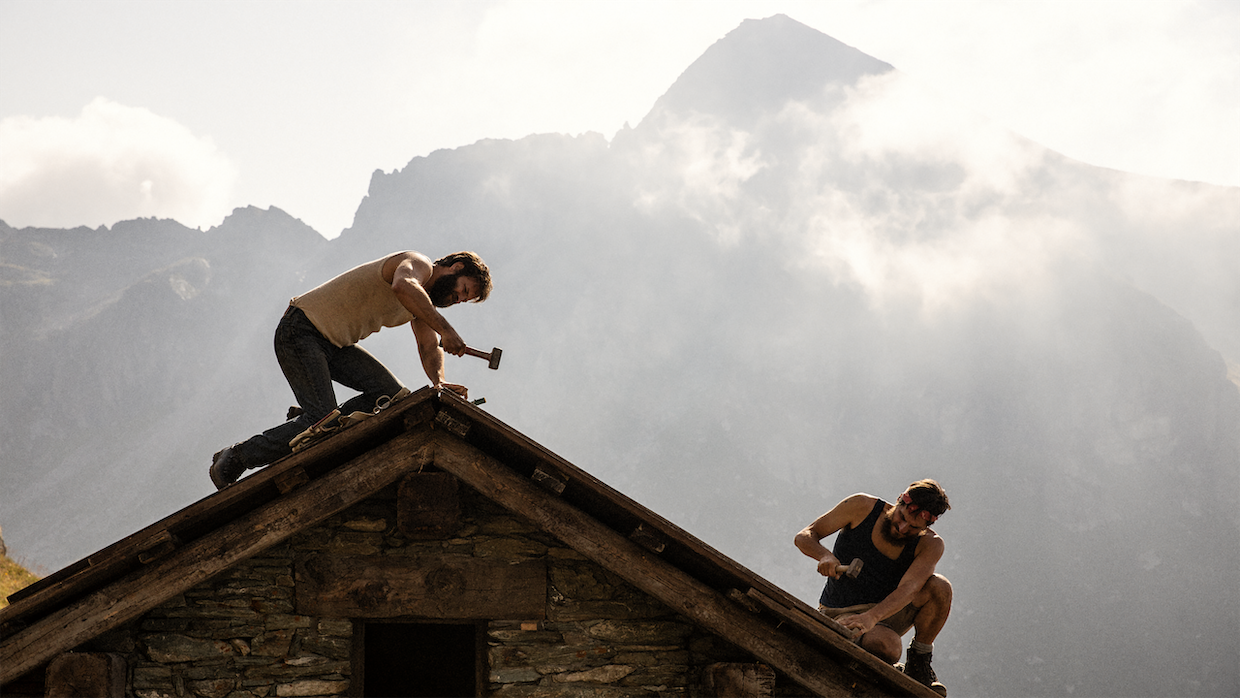 Back to selection
Back to selection
“I Studied Experimental Filmmaking, Not Editing”: Editor Nico Leunen on The Eight Mountains
 Luca Marinelli and Alessandro Borghi in The Eight Mountains.
Luca Marinelli and Alessandro Borghi in The Eight Mountains. When Pietro’s (Lupo Barbiero) father passes away and leaves him a plot of land in the small Alpine village of Grana, he decides to return to the mountainous locale to build a house. Upon his return, he bonds anew with Bruno (Cristiano Sassella), who he first met when he visited with his mother as an 11-year-old boy many years ago. The winner of the Jury Prize at the 2022 Cannes Film Festival, The Eight Mountains from directors Felix van Groeningen and Charlotte Vandermeersch is an engrossing look at a friendship that transcends time and distance.
Editor Nico Leunen tells Filmmaker all about the process of cutting the festival-favorite film.
See all responses to our annual Sundance editor interviews here.
Filmmaker: How and why did you wind up being the editor of your film? What were the factors and attributes that led to your being hired for this job?
Leunen: Director Felix van Groeningen and I go back a long time, all the way to his first feature film. Since then we’ve collaborated on all of his films, so 7 times total.
Filmmaker: In terms of advancing your film from its earliest assembly to your final cut, what were goals as an editor? What elements of the film did you want to enhance, or preserve, or tease out or totally reshape?
Leunen: In order to construct a solid spine for the story of a friendship we needed a true understanding of the importance of nature and the mountainous environment. Of course the next thing was to make the bond between these two men truly believable and worthwhile.
Filmmaker: How did you achieve these goals? What types of editing techniques, or processes, or feedback screenings allowed this work to occur?
Leunen: Omitting, amplifying, chiseling, restructuring…
Filmmaker: As an editor, how did you come up in the business, and what influences have affected your work?
Leunen: I accidentally edited a short film on Steenbeck for a fellow student in film school. The final result appealed to so many that one thing led to another. I studied experimental filmmaking, not editing, so a lot comes from that background. Jonas Mekas for example. I also listen to a million different genres of music and they inspire me a lot. Conversations in daily life as well.
Film influences, I would say editors Anne V. Coates and Juliette Welfling. Directors that I find inspiring from an editor’s point of view [include] Paul Thomas Anderson, Steven Soderbergh and Robert Altman. And I love Woodstock: The Director’s Cut.
Filmmaker: What editing system did you use, and why?
Leunen: I’ve used Final Cut Pro a lot up until version 7. AVID is my go-to for feature-length films even though you need to learn to live with its quirks and bugs and the prehistoric way of handling sound and sound effects. It still is the most stable for massive projects and easiest for multiple workstations (I usually have 3 or 4 edit suites running).
I have tried Adobe Premiere for feature films but I now mainly use it for shorter, smaller-sized projects. I would love to use Premiere for features again but I need confirmation it will be less boggy or sluggish.
Filmmaker: What was the most difficult scene to cut and why? And how did you do it?
Leunen: I don’t have a recollection of any scene being too difficult. One peculiar challenge is the scene where Pietro sees Bruno for the first time, as a kid. This was originally not the scene where they saw each other for the first time. It was a scene from much later in the film when they were already friends. One day I thought I could maybe tailor the scene to serve the purpose of a more mysterious way of meeting each other for the first time. And after some cobbling and sewing, it worked miraculously well.
Filmmaker: What role did VFX work, or compositing, or other post-production techniques play in terms of the final edit? (Feel free to ignore this question if it’s not applicable.)
Leunen: A lot of VFX work was done to have a dangerous crevasse on a glacier, but I didn’t need too much imagination to be able to cut the scene without the VFX. The performances did the job.
There was also considerable VFX done on the evolution of the mountain house they build.In real life there was a ruin next to a building that was in much better shape. So the main challenge was painting away one of the buildings. My editing assistant Alice did a great job in the offline [edit] though, to already mimic the final result. So that helped us a lot.
Filmmaker: Finally, now that the process is over, what new meanings has the film taken on for you? What did you discover in the footage that you might not have seen initially, and how does your final understanding of the film differ from the understanding that you began with?
Leunen: There’s a thousand new meanings the film has taken on. Often a film script only conveys a concept to me personally. I don’t enjoy reading scripts at all and they hardly ever move me. So once the actors bring to life the characters, meanings start coming to the surface. In the case of Le Otto Montagne specifically, the insanely good performances of Luca Marinelli and Alessandro Borghi made me feel and understand meanings that would have been impossible to read – even between the lines. So: Grazie mille a entrambi! Thank you!
